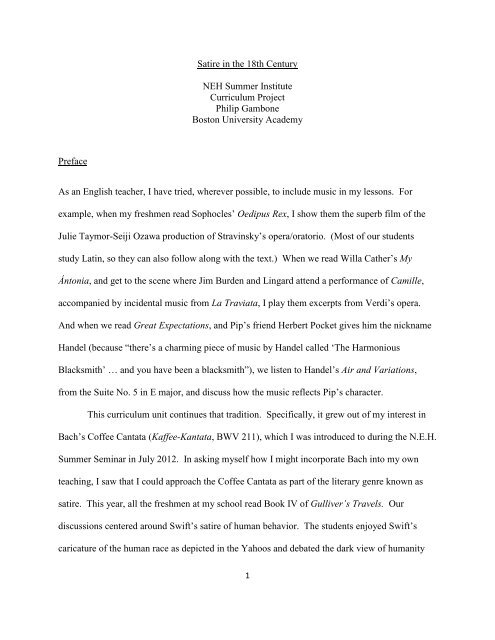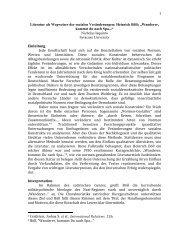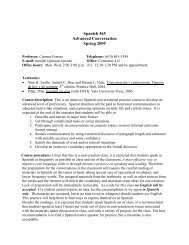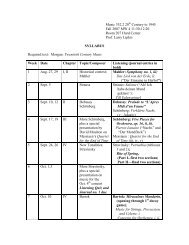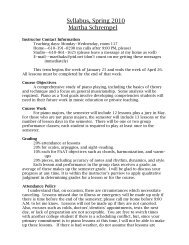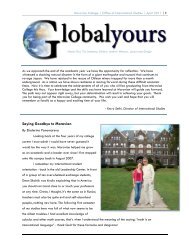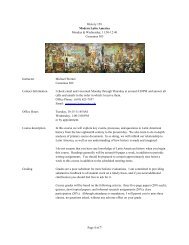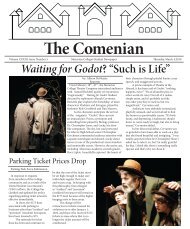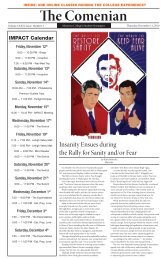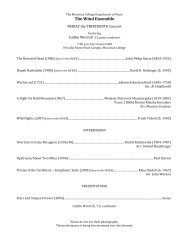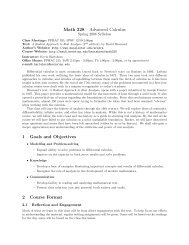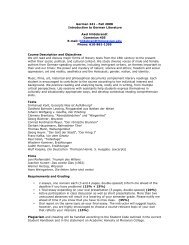Satire in the 18th Century NEH Summer Institute ... - Moravian College
Satire in the 18th Century NEH Summer Institute ... - Moravian College
Satire in the 18th Century NEH Summer Institute ... - Moravian College
Create successful ePaper yourself
Turn your PDF publications into a flip-book with our unique Google optimized e-Paper software.
Preface<br />
<strong>Satire</strong> <strong>in</strong> <strong>the</strong> <strong>18th</strong> <strong>Century</strong><br />
<strong>NEH</strong> <strong>Summer</strong> <strong>Institute</strong><br />
Curriculum Project<br />
Philip Gambone<br />
Boston University Academy<br />
As an English teacher, I have tried, wherever possible, to <strong>in</strong>clude music <strong>in</strong> my lessons. For<br />
example, when my freshmen read Sophocles’ Oedipus Rex, I show <strong>the</strong>m <strong>the</strong> superb film of <strong>the</strong><br />
Julie Taymor-Seiji Ozawa production of Strav<strong>in</strong>sky’s opera/oratorio. (Most of our students<br />
study Lat<strong>in</strong>, so <strong>the</strong>y can also follow along with <strong>the</strong> text.) When we read Willa Ca<strong>the</strong>r’s My<br />
Ántonia, and get to <strong>the</strong> scene where Jim Burden and L<strong>in</strong>gard attend a performance of Camille,<br />
accompanied by <strong>in</strong>cidental music from La Traviata, I play <strong>the</strong>m excerpts from Verdi’s opera.<br />
And when we read Great Expectations, and Pip’s friend Herbert Pocket gives him <strong>the</strong> nickname<br />
Handel (because “<strong>the</strong>re’s a charm<strong>in</strong>g piece of music by Handel called ‘The Harmonious<br />
Blacksmith’ … and you have been a blacksmith”), we listen to Handel’s Air and Variations,<br />
from <strong>the</strong> Suite No. 5 <strong>in</strong> E major, and discuss how <strong>the</strong> music reflects Pip’s character.<br />
This curriculum unit cont<strong>in</strong>ues that tradition. Specifically, it grew out of my <strong>in</strong>terest <strong>in</strong><br />
Bach’s Coffee Cantata (Kaffee-Kantata, BWV 211), which I was <strong>in</strong>troduced to dur<strong>in</strong>g <strong>the</strong> N.E.H.<br />
<strong>Summer</strong> Sem<strong>in</strong>ar <strong>in</strong> July 2012. In ask<strong>in</strong>g myself how I might <strong>in</strong>corporate Bach <strong>in</strong>to my own<br />
teach<strong>in</strong>g, I saw that I could approach <strong>the</strong> Coffee Cantata as part of <strong>the</strong> literary genre known as<br />
satire. This year, all <strong>the</strong> freshmen at my school read Book IV of Gulliver’s Travels. Our<br />
discussions centered around Swift’s satire of human behavior. The students enjoyed Swift’s<br />
caricature of <strong>the</strong> human race as depicted <strong>in</strong> <strong>the</strong> Yahoos and debated <strong>the</strong> dark view of humanity<br />
1
that he presents <strong>in</strong> his portrayal of <strong>the</strong>m as “vicious,” “odious,” “hateful,” “detestable” and<br />
“vile.” Through Gulliver, Swift satirizes—<strong>in</strong>deed, vilifies—many European <strong>in</strong>stitutions and<br />
professions. While Swift’s satire is far more st<strong>in</strong>g<strong>in</strong>g than <strong>the</strong> gentle pok<strong>in</strong>g fun that Bach and<br />
his librettist, Christian Friedrich Henrici (Picander) attempt, never<strong>the</strong>less both works are pieces<br />
of satire and date from with<strong>in</strong> ten years of each o<strong>the</strong>r: Gulliver’s Travels (1726); <strong>the</strong> Coffee<br />
Cantata (1734).<br />
As a school with a classical curriculum (all out students take at least two years of Lat<strong>in</strong> or<br />
Greek), I also wanted to draw on <strong>the</strong> students’ knowledge of ancient history and literature.<br />
F<strong>in</strong>ally, I wanted to <strong>in</strong>corporate some visual art <strong>in</strong>to whatever <strong>the</strong> f<strong>in</strong>al curriculum unit would be.<br />
The result is this two-week unit on <strong>Satire</strong> <strong>in</strong> <strong>the</strong> Eighteenth <strong>Century</strong><br />
Class 1: What is <strong>Satire</strong>?<br />
The unit would beg<strong>in</strong> with a class that would consider <strong>the</strong> genre called satire: What is it? How<br />
does it work?<br />
Work<strong>in</strong>g Def<strong>in</strong>ition: <strong>Satire</strong> is a literary genre that expresses amusement or disgust at<br />
ridiculous, unseemly and/or immoral behavior or culture. Out of a moral concern, <strong>the</strong> satirist<br />
attacks <strong>the</strong> vice and folly he/she sees around. <strong>Satire</strong> can be expressed <strong>in</strong> many artistic media:<br />
literature, art, music.<br />
We would <strong>the</strong>n proceed to read an excerpt from a classical satire, Aristophanes’ The<br />
Clouds (a play BUA freshmen read <strong>in</strong> <strong>the</strong>ir ancient history course). Po<strong>in</strong>ts to emphasize: The<br />
play lampoons <strong>the</strong> <strong>in</strong>tellectual fashions <strong>in</strong> classical A<strong>the</strong>ns and caricatures <strong>the</strong> philosopher<br />
Socrates and his teach<strong>in</strong>gs. Discussion would center on Aristophanes’ comedy and his burlesque<br />
2
of philosophers with <strong>the</strong>ir “heads <strong>in</strong> <strong>the</strong> clouds.” We might draw dist<strong>in</strong>ctions between<br />
Aristophanes’ gentle ribb<strong>in</strong>g and Swift’s more mordant approach to satire.<br />
Text: Plato and Aristophanes: Four Texts on Socrates, trans. Thomas G. West and Grace<br />
Starry West (Cornell, 1984; rev. 1998).<br />
Class 2: Roman <strong>Satire</strong><br />
Follow<strong>in</strong>g up on <strong>the</strong> previous day’s discussion, <strong>in</strong>troduce <strong>the</strong> two basic styles of Roman satire:<br />
(1) Horatian: Gentler, <strong>in</strong>volv<strong>in</strong>g good-humored ridicule as opposed to vehement<br />
denunciation.<br />
(2) Juvenalian: Harsher, more po<strong>in</strong>ted, and often attacks particular people with <strong>in</strong>vective.<br />
Most of <strong>the</strong> class will be devoted to read<strong>in</strong>g excerpts (or, if <strong>the</strong>re is time, <strong>the</strong> full text) of a satire<br />
by Horace and one by Juvenal. The choice of satires is at <strong>the</strong> discretion of <strong>the</strong> teacher. At BUA,<br />
<strong>the</strong> students use The Norton Book of Classical Literature, ed. Bernard Knox. That volume<br />
<strong>in</strong>cludes a satire by Horace (II.6: “This is What I Prayed For” and one by Juvenal (<strong>Satire</strong> III:<br />
“Life <strong>in</strong> <strong>the</strong> Big City”). These are excellent examples of <strong>the</strong>ir respective types of satire.<br />
Students should be guided toward identify<strong>in</strong>g and discuss<strong>in</strong>g (1) what is be<strong>in</strong>g satirized <strong>in</strong><br />
each poem; (2) <strong>the</strong> relative <strong>in</strong>tensity of <strong>the</strong> criticism; (3) how <strong>the</strong> word choice, style, subject<br />
matter all contribute to <strong>the</strong> <strong>in</strong>tensity of <strong>the</strong> critique. The lesson could cont<strong>in</strong>ue with a discussion<br />
of modern satirists. The teacher could br<strong>in</strong>g <strong>in</strong> a story by David Sedaris, a poem by Dorothy<br />
Parker, a pop song.<br />
3
Activity: Depend<strong>in</strong>g on time, students might be asked to generate a list of modern-day<br />
subjects that would lend <strong>the</strong>mselves to satire. Which subjects would be more appropriate to<br />
Horatian satire? Which to Juvenalian satire? Aga<strong>in</strong>, if time allows, students could be asked to<br />
write (ei<strong>the</strong>r <strong>in</strong> prose or poetic form) a short modern satire. (This would be <strong>in</strong> preparation for <strong>the</strong><br />
end-of-unit project.)<br />
O<strong>the</strong>r Sources: There are excellent essays on Horace, Juvenal, and Roman satire <strong>in</strong> Gian Biagio<br />
Conte, Lat<strong>in</strong> Literature: A History (Johns Hopk<strong>in</strong>s University Press, 1994); and Moses Hadas, A<br />
History of Lat<strong>in</strong> Literature (New York: Columbia University Press, 1952). Also useful is John<br />
Boardman, et al., The Oxford History of <strong>the</strong> Classical World (New York: Oxford University<br />
Press, 1986).<br />
Class 3: <strong>Satire</strong> <strong>in</strong> <strong>the</strong> Eighteenth <strong>Century</strong><br />
Depend<strong>in</strong>g on what course this unit falls <strong>in</strong>to, <strong>the</strong> students may or may not need some<br />
background <strong>in</strong>formation about <strong>the</strong> eighteenth century: <strong>the</strong> major political and social movements,<br />
Enlightenment philosophy, <strong>the</strong> “classical” style <strong>in</strong> music and art. If <strong>the</strong> unit falls with<strong>in</strong> a course<br />
on World History, World Culture, Art History, perhaps less of this background <strong>in</strong>formation<br />
might be required beforehand.<br />
Whe<strong>the</strong>r or not <strong>the</strong> students have a ground<strong>in</strong>g <strong>in</strong> <strong>the</strong> Eighteenth <strong>Century</strong>, <strong>the</strong> class could<br />
establish some basel<strong>in</strong>e understand<strong>in</strong>gs through some short read<strong>in</strong>gs: perhaps a short essay from<br />
Addison and Steele; Samuel Johnson’s “The Vanity of Human Wishes” (which itself is an<br />
imitation of Juvenal’s Tenth <strong>Satire</strong>); or an excerpt from Pope’s translation of Iliad or Odyssey.<br />
4
(At BUA, <strong>the</strong> students all read Robert Fagles’ translations of Iliad and Odyssey, so <strong>the</strong>y would be<br />
able to compare a 20 th -century style with Pope’s eighteenth-century style.)<br />
The purpose of this class would be to highlight critical <strong>the</strong>mes <strong>in</strong> eighteen-century<br />
aes<strong>the</strong>tics: reason, decorum, taste, neo-classicism. “Described most simply, [eighteenth-century<br />
literature] was a reaction aga<strong>in</strong>st <strong>the</strong> <strong>in</strong>tricacy and occasional obscurity, boldness, and<br />
extravagance of European literature of <strong>the</strong> late Renaissance, <strong>in</strong> favor of greater simplicity,<br />
clarity, restra<strong>in</strong>t, regularity, and good sense <strong>in</strong> all sorts of writ<strong>in</strong>g.” 1<br />
Classes 4-5: Swift<br />
The next several classes would be devoted to closer exam<strong>in</strong>ations of three pieces of eighteenth-<br />
century satire <strong>in</strong> three different genres:<br />
• Literature: Jonathan Swift, Gulliver’s Travels (1726)<br />
• Visual Art: William Hogarth, A Rake’s Progress (1732–33; engraved and published 1735)<br />
• Music: J.S. Bach and <strong>the</strong> Coffee Cantata (1734).<br />
I would beg<strong>in</strong> with Swift, both because <strong>the</strong> o<strong>the</strong>r two genres are less familiar to most high<br />
school students; and because I would use this unit <strong>in</strong> <strong>the</strong> context of an English course. It is up to<br />
<strong>the</strong> teacher’s discretion how many of <strong>the</strong> four books of Gulliver’s Travels <strong>the</strong> students would<br />
read. For <strong>the</strong> purposes of this unit on satire, I would only read Book IV: “A Voyage to <strong>the</strong><br />
1 The Norton Anthology of English Literature, vol. 1, 1135.<br />
5
Country of <strong>the</strong> Houyhnhnms.” In <strong>the</strong> Pengu<strong>in</strong> edition, this is 65 pages long, a typical two-night<br />
read<strong>in</strong>g assignment at BUA.<br />
The first class might beg<strong>in</strong> with some background on Swift. Below are notes I use:<br />
Jonathan Swift (1667-1745)<br />
Biography:<br />
• English satirist, poet, political writer, and clergyman<br />
• Born <strong>in</strong> Dubl<strong>in</strong> of English parents<br />
• Educated <strong>in</strong> Ireland<br />
–– Attended Tr<strong>in</strong>ity <strong>College</strong>, Dubl<strong>in</strong><br />
–– Undist<strong>in</strong>guished academic career<br />
–– Obta<strong>in</strong>ed degree only “by special grace”<br />
• Age 22, goes to England:<br />
–– becomes secretary to Sir William Temple, dist<strong>in</strong>guished politician<br />
–– had a splendid library<br />
–– <strong>the</strong>re learned to become a scholar & poet<br />
• Orda<strong>in</strong>ed <strong>in</strong> 1695<br />
–– becomes an Anglican priest<br />
• Writes his first satire, A Tale of a Tub (1704), about divisions <strong>in</strong> Christianity<br />
–– becomes established as a major modern “wit”<br />
• Becomes a major political writer (pamphleteer) for <strong>the</strong> moderate Tories, 1710<br />
• Appo<strong>in</strong>ted dean of St., Patrick’s Ca<strong>the</strong>dral (Anglican) by Queen Anne, 1713<br />
• Rema<strong>in</strong>s <strong>in</strong> Ireland, except for brief excursions, for <strong>the</strong> rest of his life<br />
• A member of <strong>the</strong> Scriblerus Club<br />
6
–– association of satiric writers<br />
–– to combat pedantry and <strong>the</strong> abuses of learn<strong>in</strong>g<br />
Swift, <strong>the</strong> Satirist<br />
• Hated Ireland but championed <strong>the</strong> Irish cause<br />
• A Modest Proposal (1729):<br />
–– a masterpiece of bitterness and irony<br />
–– reveals <strong>the</strong> terrible suffer<strong>in</strong>g of <strong>the</strong> Irish people<br />
–– premise: <strong>the</strong> Irish should raise children to be sold and eaten<br />
–– Swift gives recipes and six “advantages” of his proposal<br />
• Gulliver’s Travels - his greatest and most savage satire (1726)<br />
–– Based on recent vogue for travel narratives, e.g., Wm. Dampier’s Voyages<br />
–– <strong>in</strong>tended to “vex <strong>the</strong> world ra<strong>the</strong>r than divert it”<br />
• Called himself a misanthrope, but always wrote for <strong>the</strong> betterment of mank<strong>in</strong>d<br />
This last po<strong>in</strong>t—that Swift “always wrote for <strong>the</strong> betterment of mank<strong>in</strong>d”—is one we would keep<br />
com<strong>in</strong>g back to dur<strong>in</strong>g <strong>the</strong> rest of our discussions of Gulliver’s Travels and <strong>the</strong> o<strong>the</strong>r pieces of<br />
satire <strong>in</strong> this unit. Does satire help to better mank<strong>in</strong>d? If so, how?<br />
We would <strong>the</strong>n move on to <strong>the</strong> work itself. Class discussions would focus on <strong>the</strong> objects<br />
of Swift’s satire <strong>in</strong> Gulliver, Swift’s style and effectiveness. I typically give my students a series<br />
of discussion prompts. For example:<br />
7
Discussion Po<strong>in</strong>ts on Gulliver’s Travels, Book IV<br />
1. Yahoos––“deformed,” “ugly,” “odious,” “cursed,” “filthy,” “hateful,” “detestable,”<br />
“vile.” If <strong>the</strong> Yahoos are meant to portray us humans, is Swift be<strong>in</strong>g fair?<br />
2. Whom are <strong>the</strong> Houyhnhnms meant to portray? Moreover, Gulliver says that he “never<br />
had one Hour’s Sickness, while I stayed <strong>in</strong> this Island” (chap. 2). What accounts for <strong>the</strong><br />
salubrious nature of <strong>the</strong> Houyhnhnms’ land?<br />
3. Gulliver makes an <strong>in</strong>terest<strong>in</strong>g cultural observation: “that <strong>the</strong> frequent use of Salt among<br />
us is an Effect of Luxury” (chap. 2). Are <strong>the</strong>re “necessities” <strong>in</strong> our lives today that, upon closer<br />
exam<strong>in</strong>ation, we f<strong>in</strong>d to be merely luxuries? What products, customs, ideas that we deem<br />
absolutely essential could we, <strong>in</strong> fact, do without?<br />
4. Gulliver notes that <strong>the</strong> Houyhnhnms’ “Wants and Passions are fewer than among us”<br />
(chap. 4). What would it mean to live with modest wants and passions? Would this make us<br />
happier? Better?<br />
5. Swift, through Gulliver, satirizes—<strong>in</strong>deed, vilifies—many European <strong>in</strong>stitutions and<br />
professions: sailors (chap. 4), soldiers (chap. 5), lawyers (chap. 5), luxurious liv<strong>in</strong>g (chap. 6),<br />
politicians (chap. 6), <strong>the</strong> nobility (chap. 6), colonialism (chap. 12). How do you respond to<br />
Swift’s harsh depiction of European culture?<br />
6. In <strong>the</strong>ir language, Houyhnhnm means “<strong>the</strong> Perfection of Nature.” What has been<br />
perfected <strong>in</strong> Houyhnhnm nature? Is perfection possible? Is it worth striv<strong>in</strong>g for?<br />
7. The Houyhnhnms’ “grand Maxim” is “to cultivate Reason” (chap. 8). Through<br />
Reason, <strong>the</strong>y have adopted “two pr<strong>in</strong>cipal Virtues … Friendship and Benevolence” (chap. 8).<br />
Indeed, <strong>the</strong> land of <strong>the</strong> Houyhnhnms seems like a utopia. Does Swift suggest any liabilities <strong>in</strong> a<br />
life governed by pure reason alone?<br />
8
8. “My pr<strong>in</strong>cipal Design was to <strong>in</strong>form and not to amuse <strong>the</strong>e….my sole Intention was<br />
<strong>the</strong> PUBLIC GOOD,” Gulliver tells his Gentle Reader (chap. 12). What good does Swift,<br />
through his character Gulliver, <strong>in</strong>tend to effect?<br />
Class 6: Hogarth<br />
How to make <strong>the</strong> transition from Gulliver to Hogarth, from a literary genre to a visual one?<br />
Perhaps <strong>in</strong> <strong>the</strong> previous discussions of Gulliver <strong>the</strong> teacher could show some eighteenth-century<br />
illustrations of scenes from Swift’s book. Although I haven’t yet exam<strong>in</strong>ed this book, see John<br />
F. Sena, “Gulliver’s Travels and <strong>the</strong> Genre of <strong>the</strong> Illustrated Book,” <strong>in</strong> The Genres of “Gulliver’s<br />
Travels,” ed. Frederik N. Smith (Newark, DE: University of Delaware Press/London: Associated<br />
University Presses, 1992 [1990]), 101-38.<br />
Or one could just plunge <strong>in</strong>to Hogarth. (I cont<strong>in</strong>ually re-learn that high school students<br />
need less of a logical l<strong>in</strong>k or transition between one lesson and <strong>the</strong> next than <strong>the</strong>ir teachers do!)<br />
Aga<strong>in</strong>, one could beg<strong>in</strong> with some background <strong>in</strong>formation on Hogarth. Good sources of<br />
<strong>in</strong>formation are:<br />
Hogarth, Michael Rosenthal (London: Jupiter Books, 1980)<br />
Hogarth, Lawrence Gow<strong>in</strong>g (London: Tate Gallery, 1971)<br />
Hogarth, Ronald Paulson, 3 vols. (New Brunswick: Rutger’s, 1992)<br />
Hogarth's Graphic Works, 3rd rev. ed., Ronald Paulson London: The Pr<strong>in</strong>t Room, 1989)<br />
Hogarth's Progress, Peter Quennell (New York: Vik<strong>in</strong>g Press, 1955)<br />
9
A Rake's Progress comprises eight pa<strong>in</strong>t<strong>in</strong>gs, which Hogarth pa<strong>in</strong>ted <strong>in</strong> 1732–33, <strong>the</strong>n published<br />
as engrav<strong>in</strong>gs two years later. The series depicts <strong>the</strong> decl<strong>in</strong>e and fall of Tom Rakewell, who,<br />
after com<strong>in</strong>g to London, wastes all his money on luxuries, prostitution and gambl<strong>in</strong>g. He ends<br />
up thrown <strong>in</strong>to <strong>the</strong> Fleet Prison and ends his life at Bethlem Hospital, or Bedlam. The<br />
Wikipedia article on A Rake’s Progress <strong>in</strong>cludes images of all eight pa<strong>in</strong>t<strong>in</strong>gs (and <strong>the</strong> eight<br />
engrav<strong>in</strong>gs) and brief descriptions of <strong>the</strong> content of each. It can be accessed at:<br />
http://en.wikipedia.org/wiki/A_Rake%27s_Progress<br />
Suggested Lessons/Discussion Questions:<br />
1. What is a “rake”? What is <strong>the</strong> equivalent <strong>in</strong> today’s society? Pair up students and give<br />
each one of <strong>the</strong> pa<strong>in</strong>t<strong>in</strong>gs and/or engrav<strong>in</strong>gs (along with <strong>the</strong> brief description <strong>in</strong> Wikipedia) to<br />
study. Ask <strong>the</strong>m to make a list of details that are satirical: what is Hogarth pok<strong>in</strong>g fun at? And<br />
what receives even more scath<strong>in</strong>g condemnation?<br />
2. Alternately, you could give <strong>the</strong> students <strong>the</strong> pa<strong>in</strong>t<strong>in</strong>gs and/or engrav<strong>in</strong>gs without first<br />
giv<strong>in</strong>g <strong>the</strong>m <strong>the</strong> description o<strong>the</strong>r than <strong>the</strong> title and <strong>the</strong> overall “plot” of <strong>the</strong> series. What do <strong>the</strong>y<br />
see? What is go<strong>in</strong>g on <strong>in</strong> <strong>the</strong> pa<strong>in</strong>t<strong>in</strong>g? Then give <strong>the</strong>m <strong>the</strong> brief description <strong>in</strong> Wikipedia and<br />
cont<strong>in</strong>ue with #1 above. [It should be noted that <strong>the</strong> details <strong>in</strong> <strong>the</strong> engrav<strong>in</strong>gs are sharper than <strong>in</strong><br />
<strong>the</strong> pa<strong>in</strong>t<strong>in</strong>gs.]<br />
3. Tom is attracted to <strong>the</strong> “good life.” Students might be asked to catalog all <strong>the</strong><br />
examples of 18 th -century “good life” and good taste depicted <strong>in</strong> <strong>the</strong> pa<strong>in</strong>t<strong>in</strong>gs/engrav<strong>in</strong>g<br />
(especially <strong>the</strong> first six. What does Hogarth f<strong>in</strong>d <strong>in</strong> each example to criticize. What are some<br />
examples of “<strong>the</strong> good life” today that might come under a satirist’s scrut<strong>in</strong>y?<br />
10
4. Tom’s sometime girlfriend, Sarah Young, reappears <strong>in</strong> several of <strong>the</strong> pa<strong>in</strong>t<strong>in</strong>gs. The<br />
students might be asked to study <strong>the</strong>se and decide what she comes to stand for <strong>in</strong> <strong>the</strong> series.<br />
(There is a good discussion of <strong>the</strong> role of Sarah Young <strong>in</strong> <strong>the</strong> series <strong>in</strong> Paulson’s book, vol. 2.)<br />
today?<br />
5. The students could debate whe<strong>the</strong>r A Rake’s Progress is Horatian or Juvenalian satire.<br />
6. Whom would Hogarth choose to satirize today? What is <strong>the</strong> equivalent of a rake<br />
7. Students talented <strong>in</strong> art might choose to draw or pa<strong>in</strong>t a scene from a modern-day<br />
“rake’s progress.”<br />
8. If <strong>the</strong>re is time and <strong>in</strong>terest, play some of Strav<strong>in</strong>sky’s opera, The Rake’s Progress, for<br />
<strong>the</strong> class and discuss how <strong>the</strong> music (and libretto) br<strong>in</strong>gs out <strong>the</strong> satire.<br />
9. Aga<strong>in</strong>, if time, br<strong>in</strong>g <strong>in</strong> o<strong>the</strong>r examples of eighteenth-century pictorial satire: o<strong>the</strong>r<br />
pictures by Hogarth, or by Thomas Rowlandson (1756-1827) or James Gillray (1756-1815).<br />
Class 7: The Coffee Cantata<br />
Prelim<strong>in</strong>ary steps:<br />
1. Brief outl<strong>in</strong>e of Bach’s life. Use, for example, James R. Ga<strong>in</strong>es, Even<strong>in</strong>g <strong>in</strong> <strong>the</strong> Palace<br />
of Reason: Bach Meets Frederick <strong>the</strong> Great <strong>in</strong> <strong>the</strong> Age of Enlightenment.<br />
2. Brief <strong>in</strong>troduction to Baroque style. Use, for example, one of <strong>the</strong> harpsichord concerti<br />
(BWV 1052-1065). Discuss style, polyphony, <strong>in</strong>strumentation.<br />
11
3. Brief <strong>in</strong>troduction to 18 th -century coffee house culture. Use Hogarth’s engrav<strong>in</strong>g St.<br />
John’s Coffee House. (See image below.) The lesson could also start with a discussion of this<br />
picture, which would make a nice transition from <strong>the</strong> previous class on pictorial satire.<br />
There is a good web site, “Coffee House Culture <strong>in</strong> 18 th -century London,” at:<br />
http://www.umich.edu/~ece/student_projects/coffee/<br />
O<strong>the</strong>r sources of <strong>in</strong>formation about coffeehouse culture:<br />
Anthony Clayton. London’s Coffee Houses (London: Hisorical Press, 2003).<br />
R.O. Bucholz. London: A Social and Cultural History, 1550-1750 (New York:<br />
Cambridge University Press, 2012.<br />
The only book I could f<strong>in</strong>d on <strong>the</strong> history of coffee dr<strong>in</strong>k<strong>in</strong>g <strong>in</strong> Germany is:<br />
Robert Lieberles. Jews Welcome Coffee: Tradition and Innovation <strong>in</strong> Early Modern<br />
Germany. (Waltham: Brandeis University Press, 2012)<br />
12
4. What is a “cantata”? What is <strong>the</strong> difference between a secular and sacred cantata?<br />
5. I would end this class with a read<strong>in</strong>g of <strong>the</strong> libretto of <strong>the</strong> Coffee Cantata. Assign parts<br />
to students. Discuss <strong>the</strong> personalities of Schlendrian (fa<strong>the</strong>r) and Leischen (daughter). The<br />
libretto (<strong>in</strong> English and German) for <strong>the</strong> Coffee Cantata is available at:<br />
http://www.good-music-guide.com/reviews/044lyrics.htm<br />
Class 8: The Coffee Cantata<br />
Now it’s time to listen to <strong>the</strong> music. Before do<strong>in</strong>g so, you might ask <strong>the</strong> students what <strong>the</strong><br />
fa<strong>the</strong>r’s music should sound like? What voice part should he be? What would <strong>the</strong> daughter’s<br />
music sound like? What voice part would she be? How about <strong>the</strong> narrator?<br />
A good record<strong>in</strong>g of <strong>the</strong> Coffee Cantata is Kaffee-Kantate with <strong>the</strong> Amsterdam Baroque<br />
Orchestra & Choir conducted by Ton Koopman (Challenge Classics CC72280).<br />
character?<br />
Stop after each major section or aria. Questions to ask:<br />
1. How does <strong>the</strong> music express, convey, enhance <strong>the</strong> words? <strong>the</strong> personalities of each<br />
2. How does Bach br<strong>in</strong>g out <strong>the</strong> satire <strong>in</strong> Picander’s libretto?<br />
13
3. The texts for movements 9-10 (where <strong>the</strong> narrator tells us that Leischen “secretly lets it<br />
be known that she will accept no suitor who would not let her make coffee whenever she wants”<br />
and <strong>the</strong> trio, “Maidens rema<strong>in</strong> faithful to <strong>the</strong>ir coffee”) were not part of <strong>the</strong> orig<strong>in</strong>al poem.<br />
Apparently, Bach requested that <strong>the</strong>se words be added! Ask <strong>the</strong> students to speculate about why<br />
that might be. What’s ga<strong>in</strong>ed by <strong>the</strong> addition of this f<strong>in</strong>al joke?<br />
F<strong>in</strong>al Project<br />
4. Debate: whose side was Bach (and/or Picander) on?<br />
5. What k<strong>in</strong>ds of fa<strong>the</strong>r-daughter (or son) quarrels occur today?<br />
Ask <strong>the</strong> students to identify someth<strong>in</strong>g <strong>in</strong> <strong>the</strong>ir world that outrages, upsets, or annoys, amuses<br />
<strong>the</strong>m. Write an essay, story, song, “modest proposal,” spoof, dialogue—or pa<strong>in</strong>t or draw a<br />
picture; make a collage—that, through wit and exaggeration, <strong>in</strong>forms, exposes, <strong>in</strong>structs, satirizes<br />
that th<strong>in</strong>g. What style will you choose: Horatian or Juvenalian? Keep<strong>in</strong>g <strong>in</strong> m<strong>in</strong>d that Swift<br />
always “wrote for <strong>the</strong> betterment of mank<strong>in</strong>d,” expla<strong>in</strong> (verbally or <strong>in</strong> a one-page “artist’s<br />
statement”) how your piece of satire is <strong>in</strong>tended for <strong>the</strong> betterment of mank<strong>in</strong>d.<br />
I would welcome any feedback from teachers who decide to use this unit. I’m aware that<br />
it is very ambitious, and might even take longer than 8 class periods. I also th<strong>in</strong>k that portions of<br />
<strong>the</strong> unit could be used effectively.<br />
Philip Gambone<br />
Boston University Academy<br />
phil_gambone@buacademy.org<br />
14


